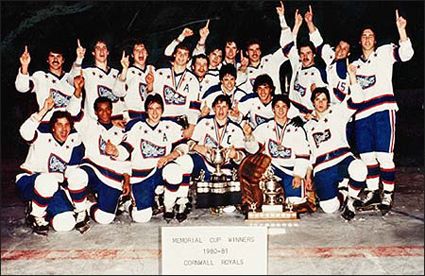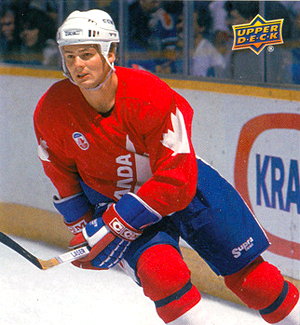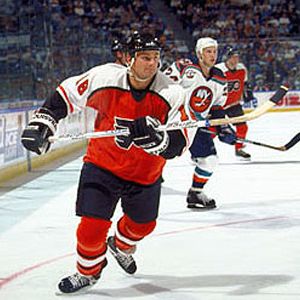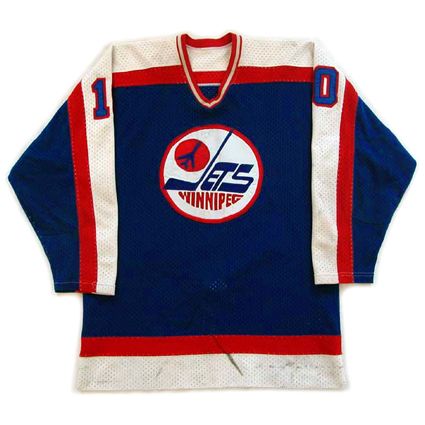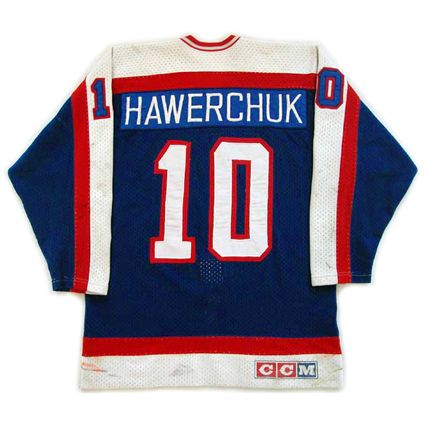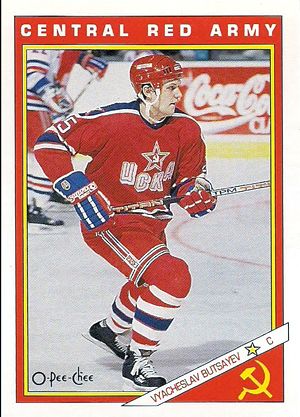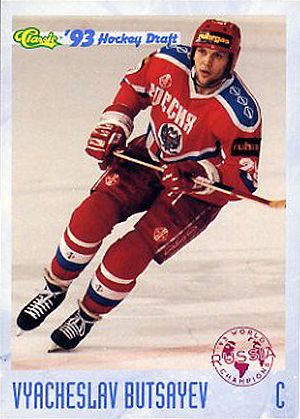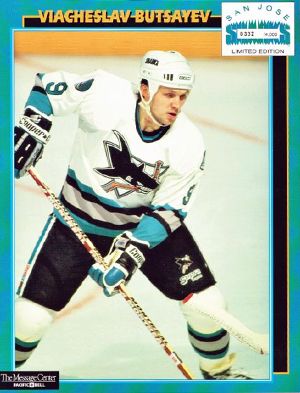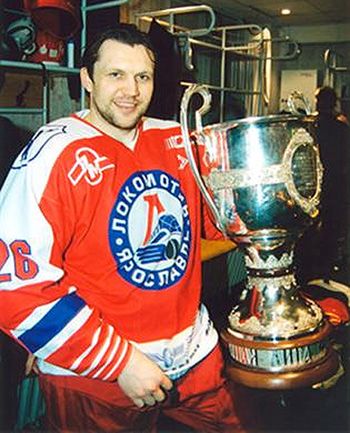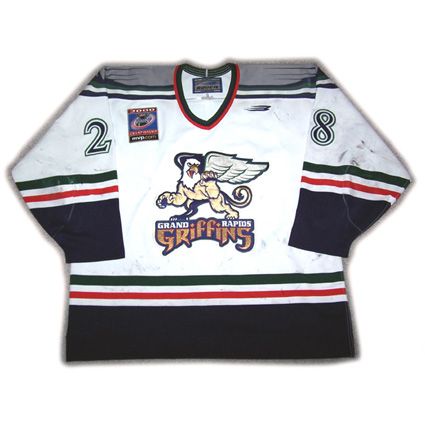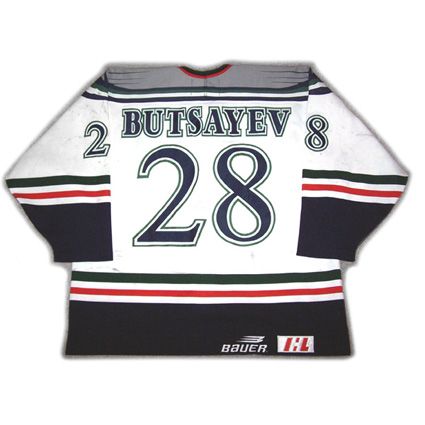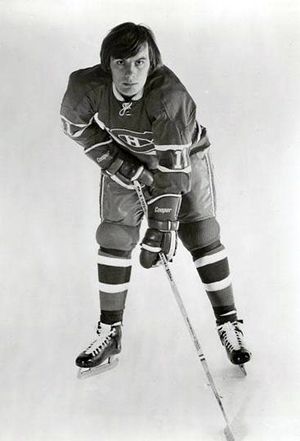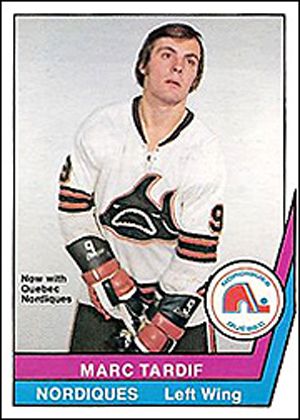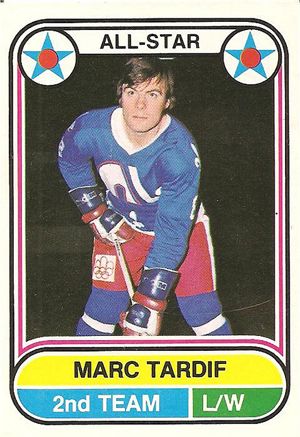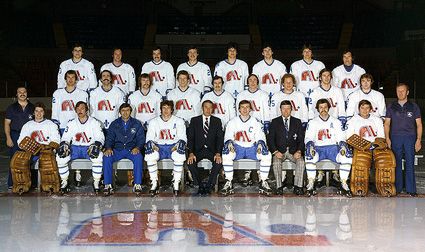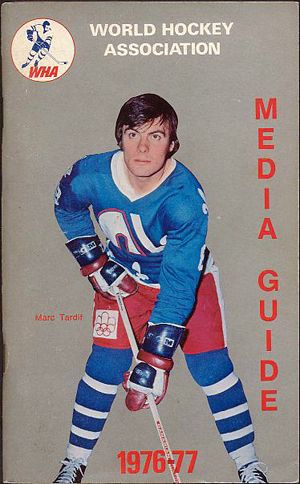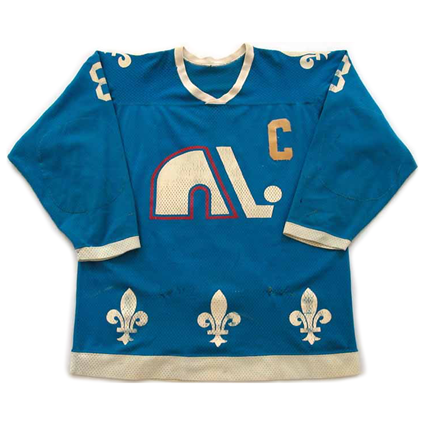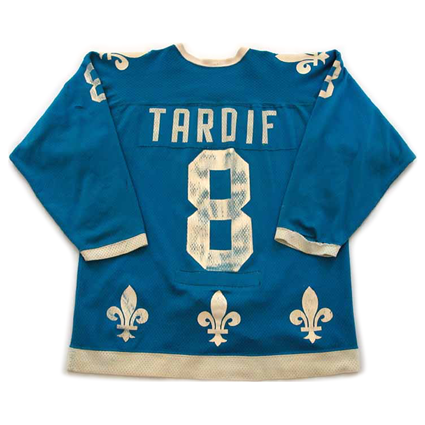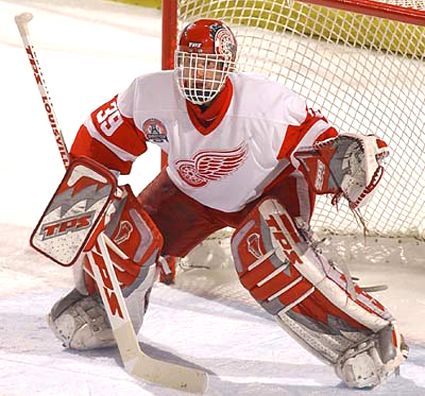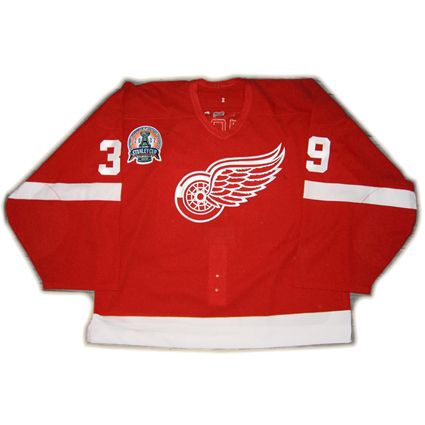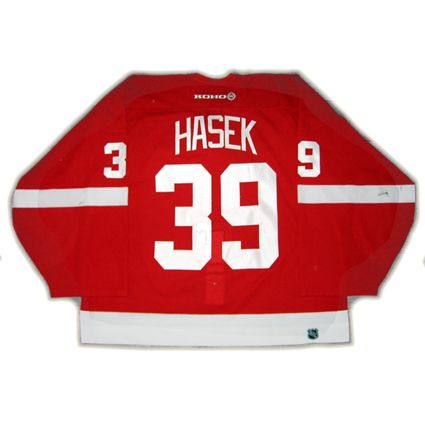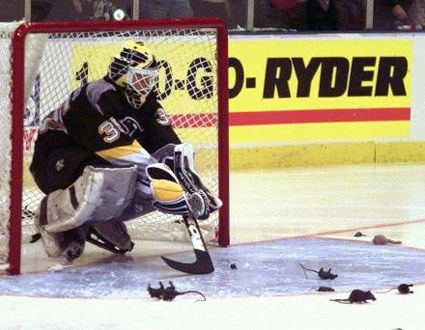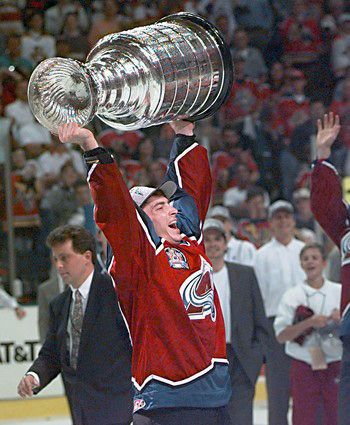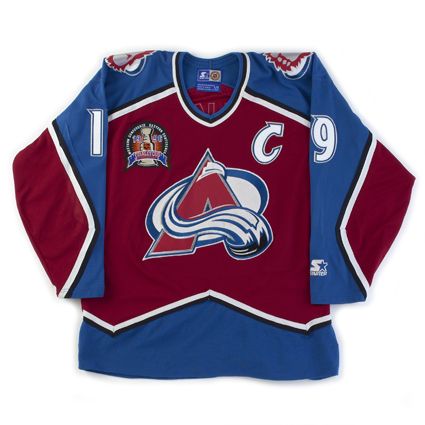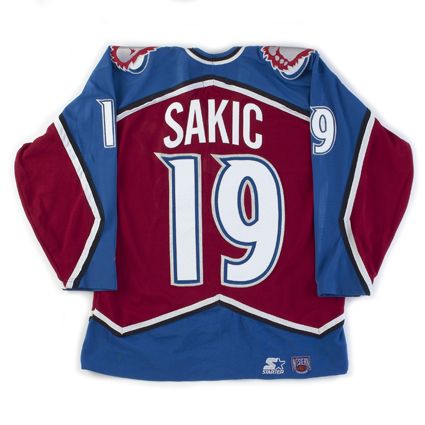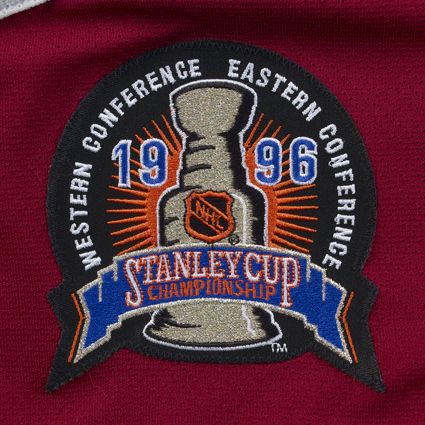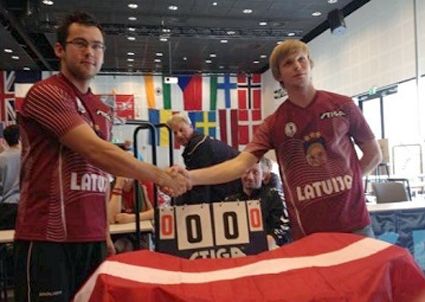Friday, June 14, 2013
1983-84 Winnipeg Jets Dale Hawerchuk Jersey
Dale Hawerchuk scored 103 points for the Cornwall Royals of the QMJHL in 1979-80 and followed up his stellar rookie season with another astonishing 45 points in 18 playoff games from 20 goals and 25 assists to lead the Royals in playoff scoring on their way to the 1980 Memorial Cup championship. He was subsequently named as the league's Rookie of the Year and Playoff MVP.
Still too young to be drafted, Hawerhcuk returned for a second season with the Royals, leading not only the team but the entire QMJHL with 81 goals and 102 assists for 183 points in just 72 games, an average of over 2.5 points per game. He tied with future NHL head coach Marc Crawford to lead the Royals in playoff points with 35 as the Royals became back-to-back Memorial Cup champions.
Hawerchuk was then named the Memorial Cup MVP as well as the QMJHL Player of the Year as well as the CHL Player of the Year, making him the prime pick in the upcoming draft.
That same season Hawerchuk made his international debut for Canada, playing in the 1981 World Junior Tournament, making a name for himself with 5 goals and 9 points in 5 games.
Thanks to their distant last place finish during their second season of play in the NHL following the demise of the WHA, the Winnipeg Jets were in prime position to select Hawerchuk with the first overall pick in the 1981 NHL Entry Draft.
Hawerchuk did not disappoint, leading the Jets to an NHL record 48 point single season improvement in the standings thanks to a team leading 45 goals and 103 points, making him the youngest player to ever reach 100 points. Additionally, he played in that season's NHL All-Star Game and won the Calder Trophy as the league's Rookie of the Year.
Following the Jets early exit from the playoffs, he made his World Championships debut, scoring three times on his way to earning a bronze medal.
Another 40 goal season followed in 1982-83 before he reeled off five consecutive seasons of 100 points or more, highlighted by his stellar 1984-85 season of 53 goals and 77 assists for 130 points, all career highs, which saw him finish 3rd in the NHL scoring race. His 50th goal on this date in 1985 made him the first Jets player to ever score 50 goals in a season in a 5-5 tie against the Chicago Black Hawks. This was also the same season when Hawerchuk was named as the Jets team captain.
During that stretch of 100+ point seasons from 1983-84 to 1987-88, Hawerchuk also participated in the 1986 World Championships (6 points in 8 games, earning a second bronze medal), Rendez-vous '87, in which a team of NHL All-Stars took part in a two game series against the Soviet Union, and the prestigious 1987 Canada Cup, during which he scored 4 goals and 6 points in 9 games as Canada emerged victorious.
While his streak of 100 point seasons would end in 1988-89 with "just" 96 points, he would extend his streak of consecutive 40 goal seasons to five. With the Jets missing the playoffs, Hawerchuk would captain Team Canada at the 1989 World Championships in Stockholm, Sweden, totaling 12 points in 10 games as the Canadians brought home a silver medal.
He would play one final season in Winnipeg before being traded to the Buffalo Sabres, along with a first round draft pick (which became Brad May) , in a blockbuster trade for Phil Housely, former Royals teammate Scott Arniel, Jeff Parker and Buffalo's first round pick, which the Jets used to select Keith Tkachuk.
Hawerchuk's goal scoring in Buffalo not approach is totals in Winnipeg, but his playmaking skills would come to the fore, as he helped set up snipers such as Dave Andreychuk, Pierre Turgeon, Alexander Mogilny and Pat LaFontaine, which allowed him to lead the club in scoring in 1991, 1992 and 1994, with a high of 98 points in 1991-92.
Prior to his second season with Buffalo, Hawerchuk made his final international appearance, skating once again for Team Canada at the 1991 Canada Cup, contributing 5 points in 8 games as the Canadians again won the tournament for the second time in his career.
For the 1995-96 season, Hawerchuk signed as a free agent with the St. Louis Blues, where he played 66 games of the 1995-96 season, which included his 500th NHL goal before a trade to the Philadelphia Flyers for the final 16 games of the season. He would return to the Flyers for the final season of his career in 1996-97, although he was limited to 51 games of the regular season, Hawerchuk closed out his career with the longest playoff run of his career which concluded with his only appearance in the Stanley Cup Finals.
Hawerchuk's final NHL totals were 518 goals and 891 assists for 1,409 points, which still ranks as #18 all-time 15 years after his retirement.
Following his career, it was announced on this date in 2001 that Hawerchuk would be one of that year's inductees into the Hockey Hall of Fame. He also had his #10 retired by the relocated Jets, now known as the Phoenix Coyotes, in 2007 and named to the Buffalo Sabres Hall of Fame in 2011.
Today's featured jersey is a 1983-84 Winnipeg Jets Dale Hawerchuk jersey. This style Jets jersey was first worn in 1979-80 as the Jets marked a new era in franchise history as they gained entry into the NHL. This style would be worn through 1989-90 when the club changed to a new style, and would be the only style worn by Hawerchuk while a member of the Jets.
Bonus jersey: Today's bonus jersey is a 1989 Team Canada Dale Hawerchuk jersey as he captained Canada to a silver medal at the World Championships. This jersey was produced by Tackla and featured the company's diamond shape logo along the shoulders. Tackla supplied jerseys for the World Juniors, the World Championships and the Olympics from 1987 to 1993.
Today's video section begins with one of our favorite videos of all time, Les Dale Hawerchuks performing their utterly brilliant song "Dale Hawerchuk".
Next, an extended look at the playing career of Hawerchuk.
Labels:
Canada,
Hawerchuk Dale,
Winnipeg Jets
Thursday, June 13, 2013
1999-00 Grand Rapids Griffins Vyacheslav Butsayev Jersey
Vyacheslav Butsayev, born on this date in 1970, began his career with Torpedo Tolyatti in the second division of hockey in the Soviet Union in 1986 at the age of 16. A center, Butsayev played well and caught the attention of the mighty Central Red Army Club (CSKA) in Moscow.
His first season in the Soviet capital came in 1989-90, which included making his international debut for the Soviet Union at the World Junior Championships, where he came home with a silver medal. Butsayev's timing was both fortunate and unfortunate, as the Soviet Union was in it's last days and the dominance of CSKA was at and end.
While Butsayev arrived during the very season CSKA had their 13 year long run of championships come to an end, the Soviet Union would dissolve after his second season with the club, which resulted in many players now making their way to North America for the riches offered by the NHL clubs eager to add the experienced and highly skilled players trained in the Soviet system.
1990-91 would see Butsayev play for both Red Army and then make his World Championship debut where he earned a bronze medal after scoring 4 goals in 10 games. His third season with CSKA was highlighted by making his only Olympics a successful one, as the team dubbed the Unified Team would win the gold medal. Later that spring he could compete in his second World Championships under the banner of the Commonwealth of Independent States.
Butsayev would play five games of the 1992-93 season with CSKA before leaving for the Philadelphia Flyers organization. Once in North America, he would play 24 games with the Hersey Bears of the American Hockey League and 52 with the Flyers, where he scored 2 goals and 16 points.
Following the season he would play for the Russian National Team at the 1993 World Championships which brought home the first gold medal for Russia and the second of Butsayev's career to go with his Olympic gold.
He would begin the 1993-94 season with the Flyers, including scoring a hat trick on December 3rd against the Vancouver Canucks, but a trade in February saw him head west to the San Jose Sharks. WIth the start of the following NHL season delayed by labor issues, Butsayev headed home to Russia and played 9 games with Lada Togliatti. He returned to North America later that season, but was limited to 13 games with the Kansas City Blades of the International Hockey League and just 6 games with the Sharks.
For 1995-96, Butsayev signed on as a free agent with the Mighty Ducks of Anaheim, but spent the vast majority of the season with the short-lived Baltimore Bandits of the AHL. It was there that he set a new personal best with 23 goals and 65 points in 62 games. In 7 games with the Mighty Ducks, he would tally 1 goal.
Adding some new stamps to his passport, Butsayev played in Sweden's Elitserien during the 1996-97 season, splitting time between Södertälje SK (16 games) and Färjestads BK (24 games). Freed from the long regular season schedule of the NHL, Butsayev would return to the World Championships with Russia for the first time in four years.
He would return to North America in 1997-98, playing the entire season with the Fort Wayne Komets of the IHL, where he had a fine season to get back on the radar of the NHL clubs, leading the team in scoring with 36 goals and 87 points in 76 games.
He was signed by the Florida Panthers, but could not crack their lineup however, and spent another season in Fort Wayne, scoring 72 points in 71 games to again lead the Komets in scoring. He did appear in one game with the Panthers, who then traded him to the Ottawa Senators in March of 1999, where he played in 2 games.
1999-98 was more of the same for Butsayev. He was claimed by the Tampa Bay Lightning in the Waiver Draft in September of 1999 and played in just 2 games for Tampa Bay before being reclaimed by the Senators off of waivers at the end of October. He would play in 3 games for the Senators, but eventually spent the bulk of his season back in the IHL with the Grand Rapids Griffins, scoring 63 points in 68 games and then adding another 16 points in 17 playoff games as the Griffins would make it to the Tuner Cup Finals.
Butsayev played the entire 2000-01 season with Grand Rapids, posting the second 30 goal season of his career with 33 on his way to 68 points in 75 games.
For the 2001-02 season, Butsayev would return to Russia where he joined Yaroslavl Lokomotiv for the first of three seasons, which included back to back championship titles in 2002 and again in 2003, which included leading the league in playoff scoring that season. 2002 would also see Butsayev take home a silver medal at the World Championships. Following his final season with Lokomotiv of 2003-04, he would make his sixth and final World Championship appearance.
He would split the 2004-05 season between Severstal Cherpovets (31 games) and his former club, CSKA Moscow (24 games). His career would wind down by playing the 2005-06 season with HC MVD and 2006-07 with HC Dmitrov of the Russian second division, the 19th team of his career.
Since the conclusion of his playing days, Butsayev has gone into coaching and now is now the head coach of CSKA Moscow in the KHL.
Today's featured jersey is a 1999-00 Grand Rapids Griffins Vyacheslav Butsayev jersey as worn during the season the Griffins made it to the Turner Cup Finals. The Griffins were formed in 1996 as members of the IHL and became affiliated with the Senators in 1999-00 and joined the AHL in 2001-02 following the demise of the IHL. Since the 2002-03 season, the Griffins have been affiliated with fellow Michigan residents, the Detroit Red Wings, located just three hours east.
Our video section today begins with the final game of the 1992 Olympics, where Butsayev and the Unified Team won the gold medal. Note the stripes across the chest of the Unified Team sweaters, but no cresting, as things were changing so rapidly with the demise of the Soviet Union, that the team wore old CCCP crested jerseys with the letters removed, but the striping still intact, including the notch where it hugged the shape of the "P"! Bonus points go to anyone who can spot #22 Butsayev.
More hockey greatness, as Butsayev and CSKA Moscow take on their rivals Dynamo Moscow from November of 1990.
His first season in the Soviet capital came in 1989-90, which included making his international debut for the Soviet Union at the World Junior Championships, where he came home with a silver medal. Butsayev's timing was both fortunate and unfortunate, as the Soviet Union was in it's last days and the dominance of CSKA was at and end.
Butsayev early in his career with Red Army
While Butsayev arrived during the very season CSKA had their 13 year long run of championships come to an end, the Soviet Union would dissolve after his second season with the club, which resulted in many players now making their way to North America for the riches offered by the NHL clubs eager to add the experienced and highly skilled players trained in the Soviet system.
1990-91 would see Butsayev play for both Red Army and then make his World Championship debut where he earned a bronze medal after scoring 4 goals in 10 games. His third season with CSKA was highlighted by making his only Olympics a successful one, as the team dubbed the Unified Team would win the gold medal. Later that spring he could compete in his second World Championships under the banner of the Commonwealth of Independent States.
Butsayev would play five games of the 1992-93 season with CSKA before leaving for the Philadelphia Flyers organization. Once in North America, he would play 24 games with the Hersey Bears of the American Hockey League and 52 with the Flyers, where he scored 2 goals and 16 points.
Butsayev with the Flyers during his rookie season in the NHL
Following the season he would play for the Russian National Team at the 1993 World Championships which brought home the first gold medal for Russia and the second of Butsayev's career to go with his Olympic gold.
Butsayev as a member of the Russia National Team in 1993
He would begin the 1993-94 season with the Flyers, including scoring a hat trick on December 3rd against the Vancouver Canucks, but a trade in February saw him head west to the San Jose Sharks. WIth the start of the following NHL season delayed by labor issues, Butsayev headed home to Russia and played 9 games with Lada Togliatti. He returned to North America later that season, but was limited to 13 games with the Kansas City Blades of the International Hockey League and just 6 games with the Sharks.
Butsayev during his tenure with the San Jose Sharks
For 1995-96, Butsayev signed on as a free agent with the Mighty Ducks of Anaheim, but spent the vast majority of the season with the short-lived Baltimore Bandits of the AHL. It was there that he set a new personal best with 23 goals and 65 points in 62 games. In 7 games with the Mighty Ducks, he would tally 1 goal.
Adding some new stamps to his passport, Butsayev played in Sweden's Elitserien during the 1996-97 season, splitting time between Södertälje SK (16 games) and Färjestads BK (24 games). Freed from the long regular season schedule of the NHL, Butsayev would return to the World Championships with Russia for the first time in four years.
He would return to North America in 1997-98, playing the entire season with the Fort Wayne Komets of the IHL, where he had a fine season to get back on the radar of the NHL clubs, leading the team in scoring with 36 goals and 87 points in 76 games.
He was signed by the Florida Panthers, but could not crack their lineup however, and spent another season in Fort Wayne, scoring 72 points in 71 games to again lead the Komets in scoring. He did appear in one game with the Panthers, who then traded him to the Ottawa Senators in March of 1999, where he played in 2 games.
1999-98 was more of the same for Butsayev. He was claimed by the Tampa Bay Lightning in the Waiver Draft in September of 1999 and played in just 2 games for Tampa Bay before being reclaimed by the Senators off of waivers at the end of October. He would play in 3 games for the Senators, but eventually spent the bulk of his season back in the IHL with the Grand Rapids Griffins, scoring 63 points in 68 games and then adding another 16 points in 17 playoff games as the Griffins would make it to the Tuner Cup Finals.
Butsayev played the entire 2000-01 season with Grand Rapids, posting the second 30 goal season of his career with 33 on his way to 68 points in 75 games.
For the 2001-02 season, Butsayev would return to Russia where he joined Yaroslavl Lokomotiv for the first of three seasons, which included back to back championship titles in 2002 and again in 2003, which included leading the league in playoff scoring that season. 2002 would also see Butsayev take home a silver medal at the World Championships. Following his final season with Lokomotiv of 2003-04, he would make his sixth and final World Championship appearance.
Butsayev celebrating his first championship with Lokomotiv in 2002
He would split the 2004-05 season between Severstal Cherpovets (31 games) and his former club, CSKA Moscow (24 games). His career would wind down by playing the 2005-06 season with HC MVD and 2006-07 with HC Dmitrov of the Russian second division, the 19th team of his career.
Since the conclusion of his playing days, Butsayev has gone into coaching and now is now the head coach of CSKA Moscow in the KHL.
Today's featured jersey is a 1999-00 Grand Rapids Griffins Vyacheslav Butsayev jersey as worn during the season the Griffins made it to the Turner Cup Finals. The Griffins were formed in 1996 as members of the IHL and became affiliated with the Senators in 1999-00 and joined the AHL in 2001-02 following the demise of the IHL. Since the 2002-03 season, the Griffins have been affiliated with fellow Michigan residents, the Detroit Red Wings, located just three hours east.
Our video section today begins with the final game of the 1992 Olympics, where Butsayev and the Unified Team won the gold medal. Note the stripes across the chest of the Unified Team sweaters, but no cresting, as things were changing so rapidly with the demise of the Soviet Union, that the team wore old CCCP crested jerseys with the letters removed, but the striping still intact, including the notch where it hugged the shape of the "P"! Bonus points go to anyone who can spot #22 Butsayev.
More hockey greatness, as Butsayev and CSKA Moscow take on their rivals Dynamo Moscow from November of 1990.
Labels:
Butsayev Vyacheslav
Wednesday, June 12, 2013
1978-79 Quebec Nordiques Marc Tardif Jersey
After playing two seasons with the Montreal Junior Canadiens, Marc Tardif was selected by the Montreal Canadiens with the second overall pick in the 1969 NHL Amateur Draft under some unusual circumstances.
Montreal had invoked their right to select two French Canadians under a provision created by the NHL back in 1936 in an effort to ensure good attendance in Montreal. This system remained in place until 1943. This rule was then brought back again in 1963, the year of the first NHL Draft, as long as the player had not already been signed by another team during the preceding years when teams would simply sign whatever young talent that appealed to them.
None of the players Montreal selected between 1963 and 1967 ever played in the NHL, but in 1968 goaltender Michel Plasse ended that streak. In 1969, it was determined this would be the final year of the special Canadiens provision, as well as teams sponsoring junior clubs, as going forward all players 20 and older would be eligible for a universal draft.
With one last chance to uncover some overlooked talent, the Canadiens struck gold when they chose Rejean Houle and Tardif. Houle would eventually play for the Canadiens from 1969 to 1973 and again from 1976 to 1983.
Tardif, born on this date in 1949, would play the majority of the 1969-70 season with the Montreal Voyageurs of the American Hockey League, amassing 27 goals and 58 points in 45 games. He would also make his NHL debut, seeing action with the Canadiens in 18 games, scoring 3 goals in the process.
Tardif would never play another game in the minors, as he established himself as a regular in the Montreal lineup beginning with the 1970-71 season. Playing time was at a premium in a lineup filled with future Hall of Famers and All-Stars such as Jean Beliveau, Yvan Cournoyer, Peter Mahovlich, Jacques Lemaire, Henri Richard and Frank Mahovlich, but Tardif held his own with 49 points in 76 games in a season which concluded with a Stanley Cup championship.
Tardif raised his point total to 53 in 1971-72 and nearly matched it with 50 points in 1972-73, a season which saw Tardif once again have his name engraved on the Stanley Cup.
Change was afoot in the world of hockey however, as that same season saw the debut of the rival World Hockey Association, who made a splash by signing no less a talent than Bobby Hull.
Aggressively looking to stock their rosters, the WHA came calling and Tardif elected to join the upstarts when he signed with the Los Angeles Sharks, immediately leading them in scoring in 1973-74 with 40 goals and 30 points. Tardif was also chosen for Team Canada in the 1974 Summit Series against the Soviet Union, registering 2 assists in 5 games.
The Sharks finished 8th out of 12 in attendance that season, but last in the standings. For 1974-75, they were sold to new owners and the franchise was relocated to Detroit, becoming known as the Michigan Stags. The whole affair was a dismal failure, and the team folded in mid-January, as they were unable to compete with the NHL's Detroit Red Wings. Fortunately for Tardif, he was gone by then, having been traded to the Quebec Nordiques in December.
Despite his late arrival, Tardif finished fourth in Nordiques team scoring with 72 points in 53 games. His 38 goals, when combined with his earlier 12 for the Stags, gave him an even 50 for the season, good for sixth in the league. Life with the Nordiques was a far cry from the Stags, as the Nordiques made it all the way to the Avco Cup Finals that season.
Now fully settled in Quebec, Tardif tore through the WHA with a stunning 71 goals (only the second professional to ever score 70 goals in a season) and 77 assists, leading the league in both categories to win the WHA scoring title with 148 points, 25 clear of Hull.
Tardif's playoffs were ended by a violent on-ice attack by Rick Jodzio of the Calgary Cowboys, which left Tardif with serious head injuries and Jodzio charged in court with bodily harm with intent to injure, as there were fears that Tardif had suffered brain damage in the assault.
Tardif was named team captain for the 1976-77 season but being limited to 62 games that year saw his point total sag to 109, but still good enough for second on the Nordiques. In the postseason, Tardif was able to play in 12 of the team's 17 games as the Nordiques would eventually capture the WHA championship, the third championship of his career.
Back to full health in 1977-78, Tardif again led the WHA in scoring with a career best 154 points from 65 goals and 89 assists, again both league leading totals. The 1978-79 season saw another 40 goal season with 41 goals and 96 points in what would be the final season of the WHA.
Under some highly restrictive terms, the Nordiques became one of four surviving WHA teams granted entry as expansion franchises in the NHL. The high flying Nordiques were gutted by the terms of the expansion deal, but Tardif was one of the few players Quebec was allowed to protect.
With the Nordiques struggling to find their way in the NHL, Tardif's point totals would plummet from the stellar levels he achieved in the WHA, but were still quite respectable. Over the final four seasons of his career, Tardif would score a high of 39 goals and 70 points in 1981-82.
His final combined career totals were 963 games played with 510 goals and 557 assists for 1,067 points with his 316 WHA goals the most in league history and 666 points second overall. He was also named the WHA's Most Valuable Player in 1976 and 1978, the two seasons he would win the scoring championship. Tardif also played in the WHA All-Star Game as well as the NHL's All-Star Game in 1982. His #8 was retired by the Nordiques in 1983.
Today's featured jersey is a 1978-79 Quebec Nordiques Marc Tardif jersey as worn during the Nordiques final season of the WHA as Tardif scored 41 goals to finish as the league's all-time leading goal scorer.
The jerseys used by the Nordiques in the WHA were a far cry from today's high tech "systems", as they were a lightweight mesh with screen printed cresting, names and numbers about at the level of today's beer leagues. Note the thinning of the number 8 on the back due to wear and repeated washings.
Keen eyed readers will notice the white logo with red trim rather than the more familiar red crest used from 1980-81 while as a member of the NHL.
Bonus jersey: Today's bonus jersey is a 1977 WHA Eastern Conference All-Star Marc Tardif jersey as worn during the East's 4-2 win over the West in Hartford. This would be the only time this exact style was worn, as the 1974 and 1975 versions had a blue background to the main crest and the format of the game was different in 1976, 1978 and 1979, which dictated different jersey styles.
For our French speaking readers, a video about the Jodzio incident which left Tardif injured and Jodzio in court. Note the presence of the police on the ice at one point!
Next up, a sports report about the Nordiques winning the 1977 Avco Cup, which includes footage of the final game and their championship parade, which all begins at the 1:44 mark after the baseball news of the day.
Finally, the end of Game 7 of the 1977 Avco Cup Finals and the post game celebrations, with Tardif accepting the Avco Cup, footage worth watching just to see how many fans ran onto the ice after the championship was won!
Montreal had invoked their right to select two French Canadians under a provision created by the NHL back in 1936 in an effort to ensure good attendance in Montreal. This system remained in place until 1943. This rule was then brought back again in 1963, the year of the first NHL Draft, as long as the player had not already been signed by another team during the preceding years when teams would simply sign whatever young talent that appealed to them.
None of the players Montreal selected between 1963 and 1967 ever played in the NHL, but in 1968 goaltender Michel Plasse ended that streak. In 1969, it was determined this would be the final year of the special Canadiens provision, as well as teams sponsoring junior clubs, as going forward all players 20 and older would be eligible for a universal draft.
With one last chance to uncover some overlooked talent, the Canadiens struck gold when they chose Rejean Houle and Tardif. Houle would eventually play for the Canadiens from 1969 to 1973 and again from 1976 to 1983.
Tardif, born on this date in 1949, would play the majority of the 1969-70 season with the Montreal Voyageurs of the American Hockey League, amassing 27 goals and 58 points in 45 games. He would also make his NHL debut, seeing action with the Canadiens in 18 games, scoring 3 goals in the process.
Tardif would never play another game in the minors, as he established himself as a regular in the Montreal lineup beginning with the 1970-71 season. Playing time was at a premium in a lineup filled with future Hall of Famers and All-Stars such as Jean Beliveau, Yvan Cournoyer, Peter Mahovlich, Jacques Lemaire, Henri Richard and Frank Mahovlich, but Tardif held his own with 49 points in 76 games in a season which concluded with a Stanley Cup championship.
Tardif raised his point total to 53 in 1971-72 and nearly matched it with 50 points in 1972-73, a season which saw Tardif once again have his name engraved on the Stanley Cup.
Change was afoot in the world of hockey however, as that same season saw the debut of the rival World Hockey Association, who made a splash by signing no less a talent than Bobby Hull.
Aggressively looking to stock their rosters, the WHA came calling and Tardif elected to join the upstarts when he signed with the Los Angeles Sharks, immediately leading them in scoring in 1973-74 with 40 goals and 30 points. Tardif was also chosen for Team Canada in the 1974 Summit Series against the Soviet Union, registering 2 assists in 5 games.
A rare shot of Tardif in a Sharks jersey
The Sharks finished 8th out of 12 in attendance that season, but last in the standings. For 1974-75, they were sold to new owners and the franchise was relocated to Detroit, becoming known as the Michigan Stags. The whole affair was a dismal failure, and the team folded in mid-January, as they were unable to compete with the NHL's Detroit Red Wings. Fortunately for Tardif, he was gone by then, having been traded to the Quebec Nordiques in December.
Despite his late arrival, Tardif finished fourth in Nordiques team scoring with 72 points in 53 games. His 38 goals, when combined with his earlier 12 for the Stags, gave him an even 50 for the season, good for sixth in the league. Life with the Nordiques was a far cry from the Stags, as the Nordiques made it all the way to the Avco Cup Finals that season.
Now fully settled in Quebec, Tardif tore through the WHA with a stunning 71 goals (only the second professional to ever score 70 goals in a season) and 77 assists, leading the league in both categories to win the WHA scoring title with 148 points, 25 clear of Hull.
Tardif's playoffs were ended by a violent on-ice attack by Rick Jodzio of the Calgary Cowboys, which left Tardif with serious head injuries and Jodzio charged in court with bodily harm with intent to injure, as there were fears that Tardif had suffered brain damage in the assault.
Tardif was named team captain for the 1976-77 season but being limited to 62 games that year saw his point total sag to 109, but still good enough for second on the Nordiques. In the postseason, Tardif was able to play in 12 of the team's 17 games as the Nordiques would eventually capture the WHA championship, the third championship of his career.
The WHA champion 1976-77 Quebec Nordiques
Back to full health in 1977-78, Tardif again led the WHA in scoring with a career best 154 points from 65 goals and 89 assists, again both league leading totals. The 1978-79 season saw another 40 goal season with 41 goals and 96 points in what would be the final season of the WHA.
The face of the WHA, league MVP Tardif
on the cover of the league media guide
Under some highly restrictive terms, the Nordiques became one of four surviving WHA teams granted entry as expansion franchises in the NHL. The high flying Nordiques were gutted by the terms of the expansion deal, but Tardif was one of the few players Quebec was allowed to protect.
With the Nordiques struggling to find their way in the NHL, Tardif's point totals would plummet from the stellar levels he achieved in the WHA, but were still quite respectable. Over the final four seasons of his career, Tardif would score a high of 39 goals and 70 points in 1981-82.
Tardif wearing an NHL era blue Nordiques jersey, now with a red crest
His final combined career totals were 963 games played with 510 goals and 557 assists for 1,067 points with his 316 WHA goals the most in league history and 666 points second overall. He was also named the WHA's Most Valuable Player in 1976 and 1978, the two seasons he would win the scoring championship. Tardif also played in the WHA All-Star Game as well as the NHL's All-Star Game in 1982. His #8 was retired by the Nordiques in 1983.
Today's featured jersey is a 1978-79 Quebec Nordiques Marc Tardif jersey as worn during the Nordiques final season of the WHA as Tardif scored 41 goals to finish as the league's all-time leading goal scorer.
The jerseys used by the Nordiques in the WHA were a far cry from today's high tech "systems", as they were a lightweight mesh with screen printed cresting, names and numbers about at the level of today's beer leagues. Note the thinning of the number 8 on the back due to wear and repeated washings.
Keen eyed readers will notice the white logo with red trim rather than the more familiar red crest used from 1980-81 while as a member of the NHL.
Bonus jersey: Today's bonus jersey is a 1977 WHA Eastern Conference All-Star Marc Tardif jersey as worn during the East's 4-2 win over the West in Hartford. This would be the only time this exact style was worn, as the 1974 and 1975 versions had a blue background to the main crest and the format of the game was different in 1976, 1978 and 1979, which dictated different jersey styles.
For our French speaking readers, a video about the Jodzio incident which left Tardif injured and Jodzio in court. Note the presence of the police on the ice at one point!
Next up, a sports report about the Nordiques winning the 1977 Avco Cup, which includes footage of the final game and their championship parade, which all begins at the 1:44 mark after the baseball news of the day.
Finally, the end of Game 7 of the 1977 Avco Cup Finals and the post game celebrations, with Tardif accepting the Avco Cup, footage worth watching just to see how many fans ran onto the ice after the championship was won!
Labels:
Quebec Nordiques,
Tardif Marc
Tuesday, June 11, 2013
2001-02 Detroit Red Wings Dominik Hašek Jersey
The Detroit Red Wings entered the 2002 Stanley Cup Playoffs as the number one seed in the Western Conference due to their league leading 116 points in the regular season standings, 15 points better than the next best team, the Boston Bruins and their 101 points, the only other club to reach 100.
The Red Wings first opponent was the Vancouver Canucks, who came into the playoffs as the #8 seed with 94 points, 22 back of Detroit. The Canucks would win the first two games in Detroit 4-3 and 5-2 to get the attention of the hockey world, but the Red Wings turned the tables back in Vancouver with a 3-1 win followed by a 4-2 triumph to even the series at 2 games apiece. Back at home Red Wings goaltender Dominik Hašek shut out the Canucks with a 25 save performance to put the Canucks on the brink and eliminated Vancouver back on their home ice with a 6-4 win, their fourth straight after losing the first two.
With both the second seeded Colorado Avalanche and third seeded San Jose Sharks winning their series, the Red Wings next opponent would be the winner of the #4 St. Louis Blues vs. the #5 Chicago Blackhawks. St. Louis prevailed 4 games to 1 to earn the right to travel to the Motor City.
Hašek greeted the Blues with a 2-0 blanking in Game 1 on 23 saves as St. Louis actually outshot Detroit by a 23-20 margin. Game 2 went the way of the Red Wings 3-2 before the series moved to St. Louis.
The Blues won 6-1 on home ice but Detroit took Game 4 by a 4-3 margin and closed out the St. Louis back in Detroit with their second shutout of the series, this one 4-0 as the Red Wings limited the Blues to just 16 shots on Hašek.
Their rivals, the Avalanche were once again the roadblock between the Red Wings and the Stanley Cup Finals as they met for the Western Conference title. While Detroit took the first game 5-3 at the Joe Louis Arena, Colorado fought back with a 4-3 overtime win in Game 2. Detroit responded with a 2-1 overtime win in Denver but the Avalanche evened the series at 2-2 with a 3-2 win in Game 4.
In Game 5, once again the Avalanche would take an overtime win in Detroit, this time 2-1 to put the Red Wings season on the line. Hašek rose to the occasion back in Denver with a 2-0 shutout in Game 6, out dueling Patrick Roy with a 24 save shutout.
The decisive Game 7 was back in Detroit and was a shocker. The first Red Wings goal came just 1:57 into the game and by the 13 minute mark it was 4-0 for Detroit and just seven minutes into the second period Roy had been chased to the bench as the Red Wings were now up 6-0. After the Red Wings made it 7-0 at the 16:09 mark, the only question that remained was would Hašek get his record setting 5th shutout in one playoff year. He would indeed, as the Detroit defense only allowed the Avalanche 19 shots for the game and Hašek completed his second consecutive blanking of Colorado to claim the record in style.
The Red Wings now moved on to the Stanley Cup Finals against the Carolina Hurricanes. Of note, the matchup between Hašek of Czechoslovakia and Carolina's Arturs Irbe from Latvia was the first matchup of two European goaltenders in NHL history.
Game 1 went to the Hurricanes 3-2 in Detroit, but the Red Wings responded with a 3-1 win in Game 2 and then took Game 3 in Raleigh 3-2. Game 4 saw Detroit limit Carolina to 6, 7 and then 4 shots on goal and Hašek turned them all away for a 17 save blanking on this date in 2002, pushing his record now out to 6 shutouts in the same playoff season.
Now up three games to one, Hašek and the Red Wings would clinch the Stanley Cup back on home ice in Detroit with a 3-1 win in Game 5 and make Hašek the first European starting goaltender to lead his team to a Stanley Cup championship.
Today's featured jersey is a 2001-02 Detroit Red Wings Dominik Hašek jersey as worn in Carolina when he extended his playoff shutout record from five to six. While it was Hašek's first season with the Red Wings, their iconic jerseys had been around since the franchise changed their name from the Falcons to the Red Wings in 1932, remaining essentially unchanged since, with only such details as changes to the number font a couple of times and the addition of names in the 1970's worth noting.
This jersey features the 2002 Stanley Cup Finals patch, a tradition which began back in 1989 which sees the two finalists wearing a commemorative patch to mark their achievement.
And you thought the Red Wings and Avalanche rivalry was over with by 2002…
Here are the Top 10 Dominik Hašek NHL moments. Among hundreds.
The Red Wings first opponent was the Vancouver Canucks, who came into the playoffs as the #8 seed with 94 points, 22 back of Detroit. The Canucks would win the first two games in Detroit 4-3 and 5-2 to get the attention of the hockey world, but the Red Wings turned the tables back in Vancouver with a 3-1 win followed by a 4-2 triumph to even the series at 2 games apiece. Back at home Red Wings goaltender Dominik Hašek shut out the Canucks with a 25 save performance to put the Canucks on the brink and eliminated Vancouver back on their home ice with a 6-4 win, their fourth straight after losing the first two.
Hašek greeted the Blues with a 2-0 blanking in Game 1 on 23 saves as St. Louis actually outshot Detroit by a 23-20 margin. Game 2 went the way of the Red Wings 3-2 before the series moved to St. Louis.
The Blues won 6-1 on home ice but Detroit took Game 4 by a 4-3 margin and closed out the St. Louis back in Detroit with their second shutout of the series, this one 4-0 as the Red Wings limited the Blues to just 16 shots on Hašek.
Their rivals, the Avalanche were once again the roadblock between the Red Wings and the Stanley Cup Finals as they met for the Western Conference title. While Detroit took the first game 5-3 at the Joe Louis Arena, Colorado fought back with a 4-3 overtime win in Game 2. Detroit responded with a 2-1 overtime win in Denver but the Avalanche evened the series at 2-2 with a 3-2 win in Game 4.
In Game 5, once again the Avalanche would take an overtime win in Detroit, this time 2-1 to put the Red Wings season on the line. Hašek rose to the occasion back in Denver with a 2-0 shutout in Game 6, out dueling Patrick Roy with a 24 save shutout.
Shutout #4 came in Denver against the Avalanche
The decisive Game 7 was back in Detroit and was a shocker. The first Red Wings goal came just 1:57 into the game and by the 13 minute mark it was 4-0 for Detroit and just seven minutes into the second period Roy had been chased to the bench as the Red Wings were now up 6-0. After the Red Wings made it 7-0 at the 16:09 mark, the only question that remained was would Hašek get his record setting 5th shutout in one playoff year. He would indeed, as the Detroit defense only allowed the Avalanche 19 shots for the game and Hašek completed his second consecutive blanking of Colorado to claim the record in style.
Hašek's shutout #5 came in his very next game
The Red Wings now moved on to the Stanley Cup Finals against the Carolina Hurricanes. Of note, the matchup between Hašek of Czechoslovakia and Carolina's Arturs Irbe from Latvia was the first matchup of two European goaltenders in NHL history.
Game 1 went to the Hurricanes 3-2 in Detroit, but the Red Wings responded with a 3-1 win in Game 2 and then took Game 3 in Raleigh 3-2. Game 4 saw Detroit limit Carolina to 6, 7 and then 4 shots on goal and Hašek turned them all away for a 17 save blanking on this date in 2002, pushing his record now out to 6 shutouts in the same playoff season.
Now up three games to one, Hašek and the Red Wings would clinch the Stanley Cup back on home ice in Detroit with a 3-1 win in Game 5 and make Hašek the first European starting goaltender to lead his team to a Stanley Cup championship.
Today's featured jersey is a 2001-02 Detroit Red Wings Dominik Hašek jersey as worn in Carolina when he extended his playoff shutout record from five to six. While it was Hašek's first season with the Red Wings, their iconic jerseys had been around since the franchise changed their name from the Falcons to the Red Wings in 1932, remaining essentially unchanged since, with only such details as changes to the number font a couple of times and the addition of names in the 1970's worth noting.
This jersey features the 2002 Stanley Cup Finals patch, a tradition which began back in 1989 which sees the two finalists wearing a commemorative patch to mark their achievement.
And you thought the Red Wings and Avalanche rivalry was over with by 2002…
Here are the Top 10 Dominik Hašek NHL moments. Among hundreds.
Labels:
Detroit Red Wings,
Hasek Dominik
Monday, June 10, 2013
1995-96 Colorado Avalanche Joe Sakic Jersey
With the financial troubles of the Quebec Nordiques mounting, they found it difficult to compete with rising player salaries, made even more difficult by a weakening Canadian dollar. Playing in by far the smallest market in the NHL, plus the language barrier facing potential free agents, unlike bi-lingual Montreal, Quebec City was virtually all French, the team owner asked for a bailout from the Quebec government, but was turned down. The team was subsequently sold to a group of investors from Denver, Colorado, where the team was moved and renamed the Colorado Avalanche.
The fans in Colorado were immediately handed a team stocked with captain Joe Sakic, Valeri Kamensky, Adam Deadmarsh, Mike Ricci, Adam Foote and Peter Forsberg. The team later added Claude Lemieux just days before the start of the season and Sandis Ozolinsh later in October.
If that weren't enough, former Montreal Canadiens captain Mike Keane and no less than Patrick Roy arrived in early December after Roy had a public falling out with the Canadiens organization, a trade that never would have happened had the franchise remained in Quebec as the Nordiques, the Canadiens bitter province rivals.
With Roy now anchoring the team in goal, they finished with a 47-25-10 record, easily winning the Pacific Division by 25 points. They defeated the Vancouver Canucks, Chicago Blackhawks and President's Trophy winning Detroit Red Wings, all by identical 4 games to 2 margins. The series against the Red Wings would kick off one of the greatest NHL rivalries, as the teams would meet in the playoff five times in seven years, with three of those being for the right to go to the finals, plus several memorable regular season brawls - which included the goaltenders! The rivalry has even been chronicled in book "Blood Feud", which can be purchased here.
The Florida Panthers would be the opponent for the Avalanche in the Stanley Cup finals, which would open in Denver. Colorado conceded the first goal in Game 1 but three goals in a five minute span of the second period would turn the game in favor of the Avalanche.
Game 2 was tied at 1-1 after eight minutes, but from then on it was all Colorado as they powered to a decisive 8-1 win as the series moved to Florida.

Game 3 in Florida saw Lemieux return from a suspension to score the first goal of the game but Ray Sheppard equalized for Florida at 9:14 and the rats rained down. The Panthers then took the lead on Rob Niedermayer's goal at 11:19 and again thousands of rats pelted ice and Roy, who was unable to escape to the safety of the bench. Following the conclusion of the first period Roy made a resolute declaration - "No more rats".
The quick-strike Avalanche needed just 1:38 into the second period to tie the game on Keane's goal before Sakic got the game winner just 1:22 later as Roy held Florida scoreless the rest of the way for a commanding 3-0 series lead.
The final game, played on this date in 1996, would be legendary. With their lives on the line, Vanbiesbrouck would match Roy save for save as the game progressed through a scoreless first period and then a second. The third period also could not produce a winner and regulation ended deadlocked at 0-0.
Colorado put on the pressure in the first overtime, outshooting Florida 11-7 but Vanbiesbrouck did not bend. The Panthers turned the tables in the second overtime 18-12 but failed to solve Roy to send the game to it's third extra period. Finally, Uwe Krupp won the cup with the cup winning goal at 4:31 for a 1-0 victory for the Avalanche. True enough, Roy kept his promise of no more rats, holding Florida scoreless for over seven periods of play following his declaration following the first period of Game 3. His streak included 18 saves for the remainder of Game 3 and 63 saves in Game 4 for a total of 81 shots and no goals.
Game 2 was tied at 1-1 after eight minutes, but from then on it was all Colorado as they powered to a decisive 8-1 win as the series moved to Florida.
One of the lasting memories of that year's playoffs were the Panthers fan's celebratory rats, which would rain down on the ice by the thousands for each Florida goal, causing opposing goalies to seek shelter inside their net until the hailstorm subsided.
The celebration stemmed from captain Scott Mellanby deftly killing a rat with a one-timer in the dressing room prior to the team's opening game of the season. When he followed it up by going out and scoring two goals that night, goaltender John Vanbiesbrouck dubbed the feat "a rat trick".

Game 3 in Florida saw Lemieux return from a suspension to score the first goal of the game but Ray Sheppard equalized for Florida at 9:14 and the rats rained down. The Panthers then took the lead on Rob Niedermayer's goal at 11:19 and again thousands of rats pelted ice and Roy, who was unable to escape to the safety of the bench. Following the conclusion of the first period Roy made a resolute declaration - "No more rats".
The quick-strike Avalanche needed just 1:38 into the second period to tie the game on Keane's goal before Sakic got the game winner just 1:22 later as Roy held Florida scoreless the rest of the way for a commanding 3-0 series lead.
The final game, played on this date in 1996, would be legendary. With their lives on the line, Vanbiesbrouck would match Roy save for save as the game progressed through a scoreless first period and then a second. The third period also could not produce a winner and regulation ended deadlocked at 0-0.
Colorado put on the pressure in the first overtime, outshooting Florida 11-7 but Vanbiesbrouck did not bend. The Panthers turned the tables in the second overtime 18-12 but failed to solve Roy to send the game to it's third extra period. Finally, Uwe Krupp won the cup with the cup winning goal at 4:31 for a 1-0 victory for the Avalanche. True enough, Roy kept his promise of no more rats, holding Florida scoreless for over seven periods of play following his declaration following the first period of Game 3. His streak included 18 saves for the remainder of Game 3 and 63 saves in Game 4 for a total of 81 shots and no goals.
With the Stanley Cup win, Russians Alexi Gusarov and Kamensky and Swede Forsberg became members of the exclusive Triple Gold Club for players who have won Olympic Gold, World Championship Gold and the Stanley Cup.
Today's featured jersey is a 1995-96 Joe Sakic Colorado Avalanche jersey with the 1996 Stanley Cup finals patch as worn by Joe when he was awarded the Conn Smythe Trophy. following his 18 goals and 34 points in the playoffs.
When the Avalanche landed in Colorado, the adopted an entirely new identity, from the singular team name, unique to the NHL colors and ground breaking jerseys, which featured the unusual striping pattern reminiscent of a mountain range.
When the Avalanche landed in Colorado, the adopted an entirely new identity, from the singular team name, unique to the NHL colors and ground breaking jerseys, which featured the unusual striping pattern reminiscent of a mountain range.
The Stanley Cup finals patch was the first of many that the Avalanche would wear with this style jersey, that would remain unchanged through the 2006-07 season.
The Stanley Cup was the first major championship for a team located in Denver, no doubt leaving the fans left behind in Quebec City to look on in yearning. The Cup was the second for a team that originated in the World Hockey Association, with the first being the Edmonton Oilers.
Labels:
Colorado Avalanche,
Sakic Joe
Sunday, June 9, 2013
2013 Table Hockey World Championships Update
The 2013 Table Hockey World Championships were narrowed down from 121 Group Stage entrants to a final group of 24 players who qualified for the head to head playoffs. With some receiving byes, those 24 were narrowed down to 16 and then the last 8 who met in the Quarterfinals.
One one of the four Quarterfinal matches progressed to a seventh game as Ahti Lampi defeated fellow Finn Jan Pelkonen. while the other three matches all saw Russians eliminated.
Lampi lost to Edgars Caics in the first Semifinal in a dramatic 2-1 Game 7 and Atis Silis prevailed, also in the full seven games, over Maxim Borisov to set up an all Lativan final.
To get to the finals, Caics went 25-3-1 to win the preliminary Group B, edging Silis who opened the tournament at 22-2-5 with Caics winnign their head to head meeting 4-3.
They were both placed in the Final Group II, which Borisov won at 23-4-4 for 50 points with Caics and Silis just behind at 49 points with Caics holding the edge at 22-4-5 and Silis at 21-3-7, but both easily advanced to the Round of 24 and drew byes based on their high placings.
In the Round of 16, Silis swept Latvian Valts Smagars in 4 while Caics needed 6 games to eliminate Russian Alexey Titov to make it to the Semifinals.
Silis took Game 1 of the finals 4-2 but Caics fought back with a 6-1 win in the second game. Silis took a close Game 3 3-2 and dominated Game 4 with an easy 7-1 win before claiming top honors with a 3-2 overtime win in Game 5 to become the first Lativan world champion in 13 tournaments.
In other results, Russia defeated Latvia to win the Team championship, Maria Miloradova took the Ladies title and Borisov took some measure of consolation by winning the Junior championship to go with his third place in the Open Division.
One one of the four Quarterfinal matches progressed to a seventh game as Ahti Lampi defeated fellow Finn Jan Pelkonen. while the other three matches all saw Russians eliminated.
Lampi lost to Edgars Caics in the first Semifinal in a dramatic 2-1 Game 7 and Atis Silis prevailed, also in the full seven games, over Maxim Borisov to set up an all Lativan final.
Caics and Silis shaking hands before the finals
To get to the finals, Caics went 25-3-1 to win the preliminary Group B, edging Silis who opened the tournament at 22-2-5 with Caics winnign their head to head meeting 4-3.
They were both placed in the Final Group II, which Borisov won at 23-4-4 for 50 points with Caics and Silis just behind at 49 points with Caics holding the edge at 22-4-5 and Silis at 21-3-7, but both easily advanced to the Round of 24 and drew byes based on their high placings.
In the Round of 16, Silis swept Latvian Valts Smagars in 4 while Caics needed 6 games to eliminate Russian Alexey Titov to make it to the Semifinals.
Silis took Game 1 of the finals 4-2 but Caics fought back with a 6-1 win in the second game. Silis took a close Game 3 3-2 and dominated Game 4 with an easy 7-1 win before claiming top honors with a 3-2 overtime win in Game 5 to become the first Lativan world champion in 13 tournaments.
In other results, Russia defeated Latvia to win the Team championship, Maria Miloradova took the Ladies title and Borisov took some measure of consolation by winning the Junior championship to go with his third place in the Open Division.
Subscribe to:
Comments (Atom)

